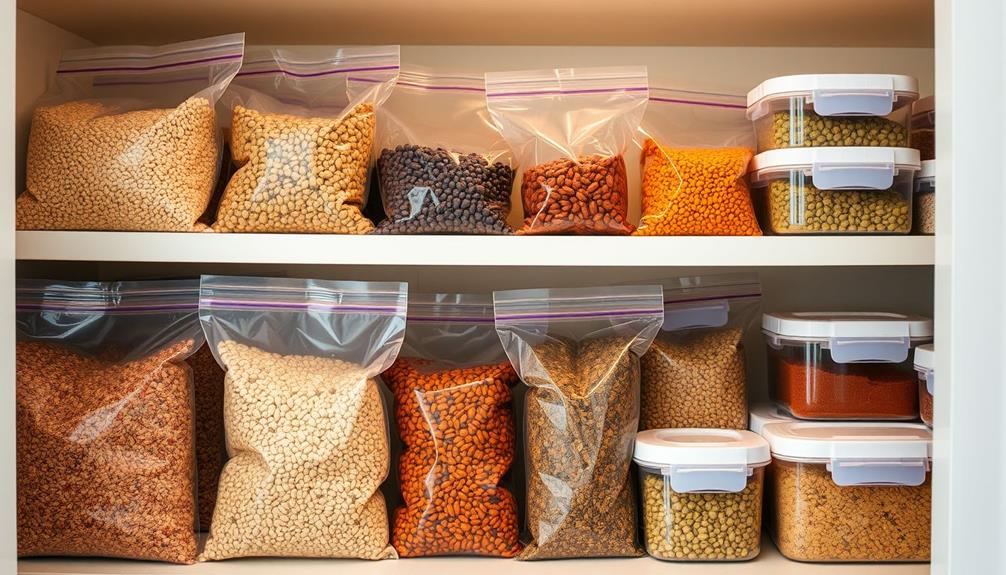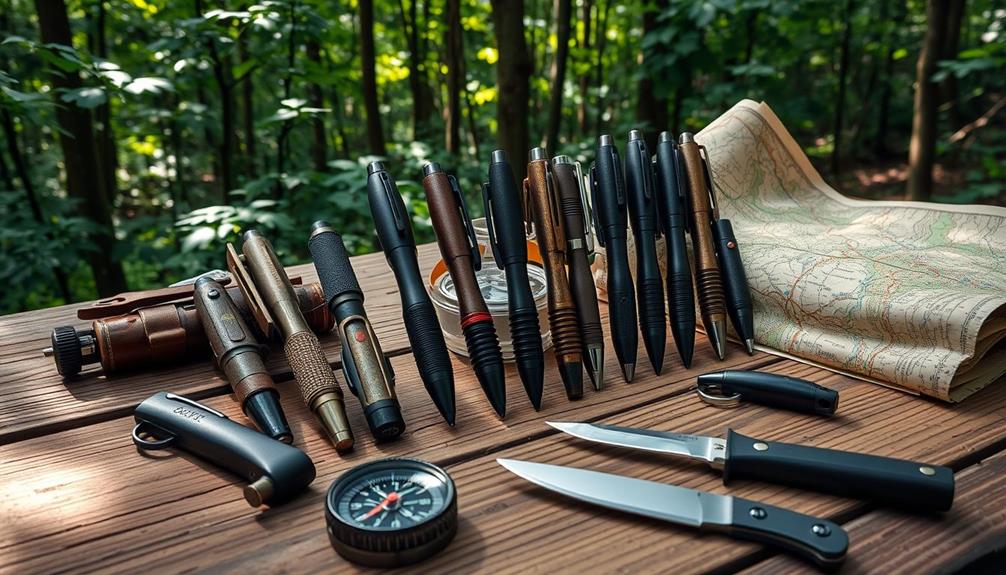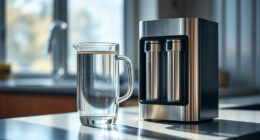In a mass outage, you've got to secure reliable water access for survival. Start by storing at least one gallon per person per day for three days. Fill FDA-approved containers beforehand and replace them biannually to avoid contamination. If tap water's suspect, boil it for at least one minute or use unscented chlorine bleach for purification. Collect rainwater or purify river water when possible. Keep track of your usage and ration wisely, prioritizing hydration over washing dishes. By implementing these strategies, you can safeguard your water supply during emergencies and discover even more tips to stay prepared.
Key Takeaways
- Store at least one gallon of water per person per day for essential hydration and sanitation during outages.
- Use FDA-approved, food-grade containers for pre-filling and storing clean water to prevent contamination.
- Boil tap water for at least one minute or use unscented chlorine bleach to disinfect suspected contaminated water.
- Collect and purify rainwater or river water as alternative sources, ensuring proper filtration and boiling for safety.
Importance of Water Storage
Storing enough water in advance is essential for you and your family to stay safe and hydrated during a mass outage. Each person needs at least one gallon of water per day, not just for drinking but also for sanitation. It's critical to have adequate water supplies ready before an emergency strikes. Public water sources can become unsafe, so relying solely on them isn't wise.
Bottled water is a convenient option, but you should also pre-fill clean containers to guarantee you have enough clean water when you need it most. Remember to replace your water sources biannually to avoid contamination, as standing water can grow harmful bacteria over time.
In your emergency plan, include a section dedicated to water storage. Detail how much water you'll need for each family member and where you'll keep it.
It's also a good idea to familiarize yourself with methods for purifying water, like using unscented chlorine bleach or boiling it for one minute, to guarantee you can safely drink if your supplies become compromised. Being prepared can make all the difference when you face a crisis.
Emergency Water Supply Strategies

Having a solid plan for your emergency water supply can make a significant difference in how well you cope during a mass outage. You need to guarantee you have enough water on hand for everyone in your household. Aim to store at least one gallon of water per person per day for a minimum of three days.
Here are some strategies to reflect on:
- Pre-fill clean containers with water using FDA-approved, food-grade containers to maintain safety.
- Boil water for at least one minute if you need to use tap water during the outage; this helps eliminate harmful bacteria.
- Include ultrafiltration systems in your emergency kit; they can purify non-sterilized water without electricity.
Safe Water Purification Methods

When facing a mass outage, knowing effective water purification methods is essential to guarantee safe drinking water for you and your family.
One of the simplest and most reliable methods is boiling water. By boiling it for at least one minute at 100 degrees Celsius, you can eliminate most pathogens. If you're at a high altitude, extend the boiling time to ascertain thorough disinfection.
Another effective method is using unscented chlorine bleach. Just add 8 drops per gallon of water, stir, and let it sit for 30 minutes. This process will kill harmful bacteria, making the water safer to drink.
Consider investing in ultrafiltration systems, like those from Waterdrop, which can purify non-sterilized water without needing electricity. These systems are especially useful during outages, providing you with a reliable water source.
Always store your water in FDA-approved, food-grade containers, and remember to replace it biannually to maintain its safety and quality.
Utilizing Alternative Water Sources

When facing a mass outage, you can tap into various alternative water sources to meet your needs.
Collecting rainwater is a straightforward method, while purifying river water can provide a valuable resource.
Additionally, utilizing water storage techniques can help guarantee you have enough for drinking and sanitation during a crisis.
Rainwater Harvesting Techniques
Rainwater harvesting techniques can greatly enhance your water supply during a mass outage, allowing you to collect and store precious resources right from your roof. By implementing a rainwater harvesting system, you can create an alternative water source that supports your needs when conventional supplies are compromised.
To get started, consider these key elements:
- Install gutters and downspouts: These capture rainwater and direct it into your storage system.
- Use food-grade storage containers: Guarantee the water you collect remains safe for consumption by utilizing appropriate containers.
- Check local regulations: Before setting up your system, confirm that you're compliant with any laws or guidelines in your area.
Purifying River Water
Purifying river water is vital for guaranteeing safe drinking water during a mass outage, and several effective methods can help you achieve this. Start by using a filtration method to remove larger debris and particles. A cloth or coffee filter works well for this initial step. Once you've filtered the water, consider the following techniques for further purification:
| Method | Description | Time Required |
|---|---|---|
| Boiling | Boil water for at least 1 minute to kill pathogens. | 1 minute (longer at altitude) |
| Ultrafiltration | Use an ultrafiltration system to remove contaminants. | No electricity needed |
| Chlorine Bleach | Add 8 drops of unscented bleach per gallon, stir, and wait 30 minutes. | 30 minutes |
Always guarantee the source of river water is as clean as possible, avoiding areas near potential contaminants like industrial sites. After using one of these methods, your river water will be ready for safe consumption. Remember, purifying river water is vital for your health and safety during emergencies.
Utilizing Water Storage
In a mass outage, tapping into alternative water sources like your water heater or toilet tank can provide essential supplies for drinking and cooking. These options can be a lifesaver when your regular water supply is compromised. Here's how to effectively utilize these sources:
- Water Heater: Turn off the power supply and let the tank cool before draining the water. This water is typically clean and safe to use.
- Toilet Tank: Only use the water from the tank, not the bowl. The tank holds clean water and can be a quick source in emergencies.
- Rainwater: If you anticipate severe weather, set out clean containers to collect rainwater. Be sure to sterilize it according to local guidelines before using it.
Remember to store water in clean, food-grade containers and replace it biannually to guarantee safety.
Rationing Water Effectively

When you're facing a mass outage, calculating your daily water needs is essential.
You'll want to implement smart rationing strategies that focus on hydration first, ensuring you stretch your limited supplies.
Calculate Daily Water Needs
To calculate your daily water needs during a mass outage, start by considering a minimum of one gallon per person to cover drinking, cooking, and sanitation. This guideline helps guarantee you have enough water for essential activities.
Keep in mind that the average adult requires about 2.5 to 3 liters daily, which is roughly half to three-quarters of a gallon.
Adjust your calculations if you have children, nursing mothers, or individuals engaged in strenuous activities in your household. To effectively ration water, focus on prioritizing hydration over other uses.
Here are some tips to help you manage your water supply:
- Keep a daily log of water usage to monitor consumption.
- Ration water for drinking first, then consider cooking needs.
- Limit non-essential uses, such as washing dishes or bathing.
Implement Smart Rationing Strategies
Implementing smart rationing strategies is essential for maximizing your limited water supply and guaranteeing everyone in your household stays hydrated and healthy during a mass outage. Start by allocating one gallon of water per person per day to cover essential needs like drinking, cooking, and hygiene.
Prioritize consuming your most perishable water sources, such as opened bottled water, before tapping into stored tap water.
Create a schedule for water usage, designating specific times for drinking, cooking, and hygiene. This helps you manage resources effectively and guarantees supplies last. Use FDA-approved, food-grade containers for any additional water storage, so it remains safe for drinking throughout the outage.
Educate everyone in your household about the importance of conserving water. Encourage practices like using minimal amounts for washing and limiting toilet flushes.
By working together to implement these rationing strategies, you can maintain a steady water supply and meet your essential needs during this challenging time.
Preparing a Water Emergency Kit

Preparing a water emergency kit means storing at least one gallon of water per person per day for a minimum of three days to stay hydrated during a mass outage. To set up your kit effectively, follow these essential steps:
- Use FDA-approved, food-grade containers to store clean tap water and avoid contamination.
- Regularly replace your water sources every six months to guarantee freshness and prevent harmful bacteria growth.
- Consider purchasing bottled water in addition to your emergency kit, especially before storms when demand spikes.
Understanding Water Contamination Risks

Water contamination risks can escalate quickly during mass outages, putting your health and safety at serious risk. Compromised public water systems can lead to the proliferation of harmful pathogens, such as bacteria and viruses, in untreated sources. It's essential to understand how to protect yourself during these emergencies.
| Contamination Source | Prevention Method |
|---|---|
| Flooded water supplies | Boiling water for 1 minute |
| Unsanitary storage containers | Use food-grade materials |
| Infrastructure failures | Monitor local advisories |
| Untreated water sources | Follow health authority guidelines |
Boiling water is a reliable way to eliminate many harmful microorganisms. Remember, even if the water looks clean, it could still be unsafe. Be certain to use proper storage containers, as unsanitary conditions can lead to chemical leaching or bacterial growth. Always prioritize water safety by keeping an eye on local advisories and following guidelines from health authorities. Taking these precautions can greatly reduce your risk of waterborne illnesses during a mass outage. Stay informed and proactive to guarantee your drinking water remains safe.
Tips for Staying Hydrated

Staying hydrated during a mass outage is vital for maintaining your health and well-being, so it's important to plan ahead. To guarantee you have access to clean drinking water, follow these tips:
- Store enough water: Aim for at least one gallon per person per day for a minimum of three days. This is essential for emergency preparedness.
- Pre-fill containers: Use FDA-approved food-grade containers to store clean water in advance. This way, you'll have safe drinking water ready when needed.
- Boil or disinfect: If you suspect your water supply is unsafe, boil tap water for at least one minute to kill harmful bacteria. Alternatively, you can use unscented chlorine bleach to disinfect, following the label instructions carefully.
Conclusion
In a crisis, remember that you can survive for about three days without water, but staying hydrated is essential for your well-being.
By implementing smart storage strategies and knowing how to purify water, you'll be better prepared for any mass outage. In the event of a mass outage, having reliable storage systems and the knowledge of water purification techniques can make a significant difference in your ability to sustain yourself and your family. By stocking up on non-perishable food items and learning how to properly filter and purify water, you can minimize the impact of a sudden loss of resources. Utilizing crisis water purification tips, such as boiling water, using water purification tablets, or investing in a portable water filtration system, can help ensure that you have access to clean and safe drinking water during an emergency.
Don't forget to utilize alternative sources like rainwater or even melting snow when necessary.
With a solid emergency kit and effective rationing, you'll not only meet your daily needs but also keep yourself and your loved ones safe.










